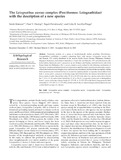The Leiognathus aureus complex (Perciformes: Leiognathidae) with the description of a new species

Associated URL
pocarisweat.umdl.umich.eduDate
2003Page views
226Metadata
Show full item recordCited times in Scopus
Share
Abstract
Taxonomic analysis of a group of morphologically similar ponyfishes (Perciformes: Leiognathidae) establishes a complex comprising three valid species: Leiognathus aureus Abe and Haneda, 1972, widely distributed in the western Pacific Ocean (Taiwan, Philippines, Thailand, Singapore, Indonesia, and northern Australia); L. hataii Abe and Haneda, 1972, currently known only from Ambon, Indonesia; and L. panayensis sp. nov. Kimura and Dunlap, currently known only from Panay Island, the Philippines. The L. aureus complex can be defined by the following combination of characters: mouth protruding forward, not downward; small but sharp conical teeth uniserially on jaws; a black line between lower margin of eye and lower jaw articulation; and lateral line incomplete, ending below posterior part of dorsal fin base or on anterior caudal peduncle. Leiognathus hataii differs from both L. aureus and L. panayensis in having a large dark blotch below the spinous dorsal fin base and fewer counts of scales (lateral line scales 50–58 vs. 64–85 in the latter two species; scales above lateral line 7–10 vs. 12–18; scales below lateral line 22–26 vs. 30–41). Leiognathus panayensis is distinguished from L. aureus in having a deeper body (41–51% SL vs. 35–45% SL in the latter), long posterior limb of maxilla (21–25% HL vs. 15–23% HL), wholly scaled belly (vs. naked along preanal median keel), and a dark blotch on nape (vs. absent).
Suggested Citation
Kimura, S., Dunlap, P. V., Peristiwady, T., & Lavilla-Pitogo, C. R. (2003). The Leiognathus aureus complex (Perciformes: Leiognathidae) with the description of a new species. Ichthyological Research , 50(3), 221-232. https://doi.org/10.1007/s10228-003-0160-z
Subject
Taxonomic term
Collections
- AQD Journal Articles [1215]


